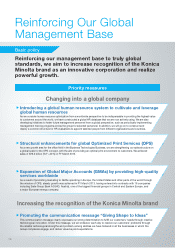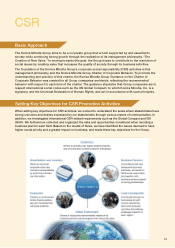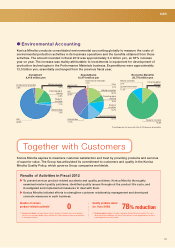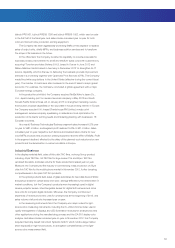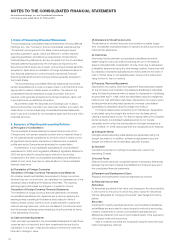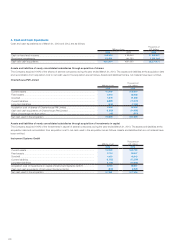Konica Minolta 2013 Annual Report Download - page 24
Download and view the complete annual report
Please find page 24 of the 2013 Konica Minolta annual report below. You can navigate through the pages in the report by either clicking on the pages listed below, or by using the keyword search tool below to find specific information within the annual report.
(6) Quality Problems
The Group has created a rigorous quality assurance system for
Group companies and contract manufacturers in Japan and
overseas, and provides customers with high-performance,
reliable products and services. The Group could be responsible
for compensation for damages that result if the Group should
happen to provide defective products or services. Moreover,
remedying such defects may result in signifi cant expenses. In
addition, media reports on such problems could adversely affect
the Group’s operations and image.
(7) Global Business Activities
The Group conducts a majority of its business outside Japan in
North America, Europe and Asian countries. These global
corporate activities entail the following risks:
• Exchange rate movements
• Political and economic uncertainties
• Unanticipated changes to legal, regulatory and tax codes
• Hiring and retaining outstanding employees
• Industrial infrastructure vulnerabilities
The Group considers it is vital to expand its business in
overseas markets, and inability to respond adequately to these
characteristic risks of global business activities could adversely
affect the Group’s results and growth strategy.
The Group is concentrating on expanding production in
China to enhance cost competitiveness in its core Business
Technologies Business and Industrial Business. The Business
Technologies Business has established two production bases in
Dongguan and Wuxi that produce and ship nearly all of the
MFPs, printers and production printing equipment it sells globally.
In addition, the Industrial Business has established production
bases in Dalian and Shanghai that produce image input/output
components and other products.
China continues to develop economically and make progress
in areas such as improving its legal system and upgrading
infrastructure. However, legal changes, labor policy diffi culties,
increased personnel expenses, appreciation of the Chinese yuan,
changes in import and export regulations and the tax code, and
other developments that are diffi cult to anticipate may occur.
Inability of the Group to effectively handle the risks inherent in
having a large percentage of the manufacturing activities of its
core businesses in China could adversely affect the Group’s
results and growth strategies.
(8) Securing Human Resources
Skilled human resources are the source of growth for the Group.
The Group increasingly requires outstanding engineers and highly
skilled workers who can further develop core technologies in
businesses including optics, materials, precision processing, and
imaging in order to maintain the Group’s high level of
competitiveness in the future. In addition, prevailing over
competitors as digitalization and networking advance requires
the Group to secure outstanding engineers and systems
engineers to quickly strengthen information and communication
technologies such as software and control technologies. Beyond
technology, the Group has a growing need for personnel in areas
such as marketing, sales and service to create new sources of
earnings from businesses including solutions and services.
However, there is a large demand for such human resources,
and competition between companies to secure human resources
is intense. Inability of the Group to secure and retain skilled
human resources could adversely affect the execution of the
Group’s growth strategies.
(9) Alliances with Other Companies
The Group is enhancing competitiveness and effi ciency by
collaborating with other companies through means including
technology and business alliances and joint ventures.
In the Business Technologies Business, the Group has
aggressively promoted M&As to expand sales of output units,
chiefl y MFPs, and business solution services and transform the
nature of its business in the future. In the offi ce fi eld, the Group
made two acquisitions in Europe and fi ve in the United States to
strengthen its IT service capability, which is the key to delivering
the business process improvement services it is promoting
together with Optimized Print Services (OPS). In the production
print business, the Group made a total of three acquisitions in
Japan, Europe and Asia to further strengthen competitiveness in
the corporate in-house printing fi eld and to expand the scope of
its business into the entire production print fi eld, which includes
the commercial market. The Group will continue to forge
alliances with other companies and make acquisitions as a
strategic growth option.
Mutually supplementing technology and expertise under
agreements with other companies strongly helps the Group to
provide new products and services that respond to customer
needs in a timely manner. Inability to continue collaborative
relationships for operating, fi nancial or other reasons or inability
to achieve the expected outcomes of such relationships could
adversely affect the Group’s growth strategy.
(10) Rising Raw Material Prices
Rising prices for metal products including silver, steel and
aluminum; petrochemical products made from crude oil; scarce
natural resources such as rare earth minerals; and other raw
materials that the Group uses in its production activities could
affect the Group’s results.
The Group works to reduce costs and raise the prices of its
products as raw material prices rise, but cannot guarantee that it
will be able to completely compensate higher raw material prices.
Raising product selling prices may also reduce sales volume.
(11) Raw Material and Resource Procurement
The Group procures specifi ed products, components and
materials from external suppliers. Unanticipated contingencies
among these suppliers could adversely affect the Group’s
production and supply capabilities.
23


